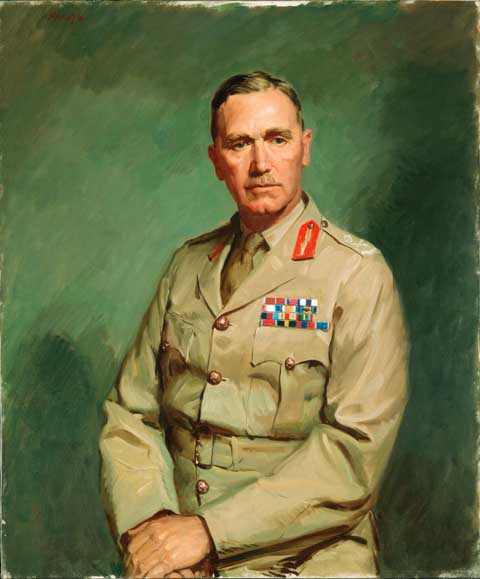The Artists
Sir William Dargie
WILLIAM DARGIE
LIEUTENANT-GENERAL the HONOURABLE SIR EDMUND HERRING
K.B.C., D.S.O., M.C., E.D., 1945

WILLIAM DARGIE
Born 1912
LIEUTENANT-GENERAL
the HONOURABLE SIR EDMUND HERRING
K.B.C., D.S.O., M.C., E.D., 1945
oil on canvas
91.8 x 76.6 cm
Collection: Australian War Memorial (22563)
Acquired under official war art scheme
File: 206/002/007
IV and 205/002/026
Second World War; 1945; Melbourne, Victoria; portrait; 1st Australian
Corps;
Lieutenant General Sir Edmund Francis Herring, K.B.E., D.B.O., M.C., E.D.,
M.A., D.C.L. (Oxon), K.C.,
General Officer Commanding 1st Australian Corps
This work was awarded the Archibald Prize for 1945.
This work was acquired by the Australian War Memorial, Canberra under the Official War Artist commission 1945.
The work is illustrated in the Peter Ross book 'Let's Face It', published in 1999, and in the entry for this work we are informed by Ross that it was one of 200 works submitted for the Archibald Prize by 123 artists. The prize money for that year was 441 pounds 8 shillings and 2 pence, and the exhibition dates were from 17 January to 19 February 1946.
Ross notes that ' William Dargie's winning portrait of Edmund Herring, a military officer and the Chief Justice of Victoria, was painted as part of his work as official war artist for the War Memorial in Canberra.'
William Dobell entered a portrait of Professor Giblin, but 'as a trustee of the Gallery, absented himself from the judges' meeting. The final decision was between Dargie's and Dobell's work; Dargie received seven votes to Dobell's five.'
In this year there was a new record number of entries, but attendances were down on the previous year from 90,000 to 50,000.
Ross further noted that once again Dargie received harsh criticism, 'although criticism was centred not on the dull orthodoxy of the winning portrait, nor its 'timid objectivity', but on the crowded nature of the exhibition.'
On 3 August 1946, the Gallery trustees announced that the conditions of the Archibald Prize would be altered so that 'in future all entries would be viewed by a selection committee and only those 'deemed worthy' would be hung. In addition, no artist might submit more than two works.'
Dargie's portrait of Herring, went through nearly as much drama as his previous winning work of Gordon, although this time it was fire and not water that came close to claiming the work.
Anna Waldmann in
her article on 'The Archibald Prize' in the Summer 1982 edition of Art
and Australia notes that while Dargie was painting his portrait of
Herring 'a fire broke out in the Melbourne building where his studio was
located and he ran into Collins Street with the half-finished picture
under his arm.
Since the work was executed while Dargie was Official War Artist, it remained
the property of the Australian War Memorial.'
Bernard Smith commenting on this work in his book on 'Noel Counihan' published in 1993 noted that "Herring was just the kind of 'distinguished Australian' that J.F.Archibald had in mind when he created the prize. A few years later Herring would be one of the prime movers in the notorious, 'Call to the people of Australia' on Remembrance Day, 11 November 1951, that set itself to warn the nation against alien philosophies 'which sap the will and darken the understanding and breed evil dissentions.'"
Sir Edmund Herring
was a great Australian, a distinguished soldier and administrator, who
was born at Maryborough, Victoria on 2 September 1892 and who died on
5 January 1982, and was given a State Funeral.
Among other accomplishments, he was Chief Justice of Victoria from 1944
to 1964, and Lieutenant-Governor of Victoria from 1945 to 1972.
During the Second World War, Herring led the Royal Australian Artillery
as part of the 6th Division (1939-1941), and commanded successfully the
6th Division, the Northern Territory Force, II Australian Corps, I Australian
Corps and the New Guinea Force during the operations which led to the
capture of Buna and Gona.
He also served for five years as chairman of the Australian War Memorial
Board of Trustees.
Further information on Sir Edmund Herring can be found in the book by Stuart Sayers 'Ned Herring, A Life of Lieutenant-General the Honourable Sir Edmund Herring', published in 1980. There is also an entry in 'The Australian Encyclopaedia', 6th ed., 1996.
The entry in 'Who's Who in Australia', 1980, gives a brief outline to the distinguished life of Sir Edmund Herring.
In 1958, Ivor Hele painted a commissioned portrait of Sir Edmund Herring, and as with Dargie's portrait of Sir Edmund Herring, this work is also in the collection of the Australian War Memorial.
Copyright Notice
No works
can be copied from this site. Permission to publish or reproduce can be
sought from the Australian
War Memorial. All Rights Reserved medialaunch
Pty. Ltd.
Left:
Arthur Streeton - Above Us The Great Grave Sky, 1890
Collection: National Gallery of Australia, Canberra.
ABN 69 067 524 921
Tel: +61 3 98185700 Fax: +61 3 98185044
Email: editor@artistsfootsteps.com